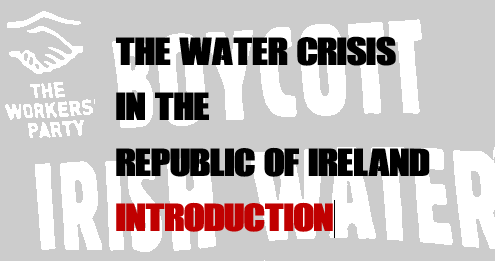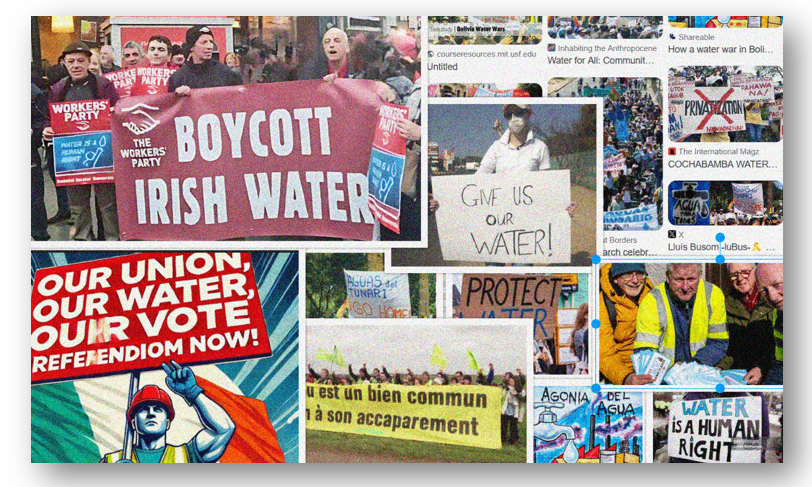Part One of a series of articles on Ireland's struggle against water charges

The struggle against water charges in Ireland has been described as the largest social movement in Ireland since independence. The movement against water charges in Ireland was a de facto anti-austerity movement where the blockading of water metre installations, non-payment of bills (up to 50 per cent) and huge protests of up to 200,000 people offered people the opportunity to express their anger and disdain.
Water privatization was seen as a crucial part of restructuring in the European Union (EU) in response to the global financial and Eurozone crises. In Greece, Ireland, and Portugal the Eurozone crisis was used as a means to push for water privatization in exchange for bailout agreements. Irish citizens successfully resisted these reforms through disruptive practices from below, and the reforms were eventually abandoned.
In its latest National Development Plan the Coalition government says that Uisce Éireann will get €4.5 billion in funding for large-scale and smaller projects, including ones to help with house building. The Department of Housing will also get €7.7bn for water investment. The ESB gets €1.5bn and Éirgrid gets €2bn for water investment. This Keynesian investment, if it happens. is partly due to the fear that the water protests instilled in Fine Gael and Fianna Fáil.
Water provision remains a contested area in Ireland. Uisce Éireann is involved in massive outsourcing to private consultants. and the government may introduce charges for overuse of water in future. Meanwhile, Multinational Corporations divert enormous amounts of water to cool down their machines in massive data centres on Irish soil. The struggle continues and the Workers Party is ready for the struggle.
Global water struggles
By the early 20th century. water services were under the control of local municipalities in nearly all European countries as the small-scale private companies which had previously supplied water lacked the capacity for large-scale investment and required higher rates of return required to make a profit. The market was not adequate to the task. Beginning in the late 1970s as part of the turn away from welfare state provision in capitalist countries, privatisation of state-owned utilities was on the agenda of right-wing and fascist politicians.

Water privatisation had been most fully realised in Pinochet’s Chile through water reforms in 1981 and in the Thatcher government’s privatisation of water companies in England and Wales in 1989. In addition, new private companies, led by the French transnational corporations Veolia and Suez pushed for water privatisation in Central and Eastern Europe following the counterrevolutions of the early 90s, and in Latin America and Africa.
As with the expropriation of other public goods, water grabbing was justified by appeals to greater efficiency, better quality and lower service costs, and received the institutional backing of the International Monetary Fund (IMF) and the World Bank. Instead of the promised improved outcomes, the only winners were the multinationals and their shareholders, while customers paid the price with higher costs, For example, despite unchanging operating costs and, water prices in the UK have increased by 50 per cent since privatisation
In the early 2000s, because of a lack of profitability and public resistance, these private corporations largely withdrew from the Global South. The retreat from the South was primarily due to difficulties in turning an adequate profit, but these decisions were also affected by number of uprisings in Cochabamba, Bolivia (2000), and la Paz (2004) which led to the termination of the private water contracts.
Private water companies began to change their focus. For instance, they demanded further privatisation in the Global North: European peripheral countries including Greece, Ireland and Portugal were pressured to privatise through bailout agreements during the Eurozone crises.
During the 21st century, despite the private-sector onslaught, water utilities throughout the world have remained overwhelmingly in public hands and 90% of urban water supply and sanitation services are currently in the public sector. They are owned by the state or local authorities and by collectives or cooperatives. The unpopularity of privatization has led many cities to return water provision to the public sector. According to the Public Futures database, between 2008-2025 300 water providers, including entire countries such as Rwanda, have been brought back into public ownership.
Two countries— Uruguay and Netherlands — have gone so far as to make water privatisation illegal. In Ireland, the Programme for Government of 2020 made a commitment to “retain Irish Water in public ownership as a national, standalone, regulated utility”. However, since then the Government has not acted on its promise to stage a referendum on water ownership.
